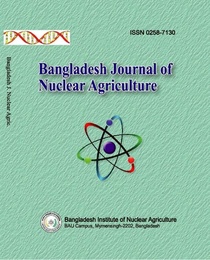IMPACT OF DIFFERENT BORON LEVELS ON YIELD IN GROUNDNUT VARIETIES
Abstract
An experiment was carried out to study the effect of different levels of boron (B) on yield of three bold seeded groundnut cultivars viz., Binachinabadam-1, Binachinabadam-2 and Binachinabadam-3. Plants were grown in sand using nutrient solution in the pots. The experiment comprised six levels of boron viz., 0, 1.5, 2.0, 2.5, 3.0 and 3.5 kg ha-1. Results indicated that physiological parameters, reproductive characters, yield attributes and pod yield increased with increasing levels of boron application till 2.5 kg B ha-1. The highest total dry matter (14.02 g plant-1), number of opened flowers (44.07 plant-1) and reproductive efficiency (46.53%) were recorded in 2.5 kg ha-1 and the lowest was recorded in 3.5 kg B ha-1 except reproductive efficiency. The highest number of pods plant-1 (20.67), single pod weight (832 mg) and pod weight plant-1 (17.09 g) was observed in 2.5 kg B ha-1 application followed by 2.0 kg B ha-1. In contrast, application of B @ 3.5 kg ha-1 showed the lowest number of pods (8.60) and pod yield (6.94 g). Among the varieties, Binachinabadam-1 produced the highest pod yield (12.81 g plant-1).
References
Ahmad, N., Abid, M., Ahmad, F., Amanullah, M., Javid, Q. and Arif, A. M. 2011. Impact of boron fertilization on dry matter production and mineral constitution of irrigated cotton. Pakistan J. Bot. 43: 2903-2910.
Ansari, M. A., Prakash, N., Singh, I. M., Sharma, P. K. and Punitha, P. 2014. Efficacy of Boron Sources on groundnut Production under North East Hill Regions. Indian Res. J. Ext. Edu. 14: 123-126.
Badruddin, M. 2005. Laboratory manual for plant and soil sample analysis. Bangladesh Institute of Nuclear Agriculture, P. O. Box # 4, Mymensingh, Bangladesh. pp. 25-27.
Chitdeshwari, T. and Poongothai, S. 2003. Yield of groundnut and its nutrient uptake as influenced by Zinc, Boron and Sulphur. Agril. Sci. Digest 23: 263-266.
Fakir, M. S. A, Mondal, M. M. A., Ismail, M. R. and Ashrafuzzaman, M. 2011. Flowering pattern and reproductive efficiency in mungbean. Int. J. Agric. Biol. 13: 966-970
Hewitt, E. J. 1966. Sand and water culture methods used in the study of plant nutrition. Commom. Bureau Hort. Tech. Commun, 2nd Ed, Vol. 22, Fairham, Royal, England.
Hoque, M. S. 1989. Role of legumes in soil fertility and need for Rhizobium inoculum for increasing production. Lecture note prepared for training on “Legumes”. Organized by BARI and sponsored by ICRISAT, held on September 9-18, 1989 at BARI, Gazipur-1701.
Mondal, M. M. A., Akter, M. B., Rahman, M. H. and A. B. Puteh, 2016. Influence of micronutrients and manures on yield of garlic in sandy loam soil. Int. J. Plant Soil Sci. 14: 507-510.
Newaz , N., Nawaz, M. S., Khan, M. A., Yasin, M. M., Baig, D., Cheema, N. M., Amjad, M. and Sher, M. A. 2014. Effect of boron on peanut genotypes under rainfed conditions. Pakistan J. Agric. Res. 27: 110-117.
Rerkasem, B. and Jamjod, S. 2004. Boron deficiency in wheat – A Review. Field Crops Res. 89: 173-186.
Russell, D. F., 1986. MSTAT-C computer package programme,” Crop and Soil Science Department, Michigan State University, USA.
Shankhe, G.M., Sonune, B.A. and Naphade, P.S. 2003. Influence of boron and molybdenum on yield and quality of groundnut. Ann. Plant Physiol. Publ. 16: 157-159.
Singh, M. V. 2001. Response of micronutrient to crops in different agro-ecological regions- Experiences of AICRP Micronutrients. Fert. News 46:43-49.
Singh, A. K., Khan, M. A. and Srivastava, A. 2014. Effect of boron and molybdenum application on seed yield of mungbean. Asian J. Bio Sci. 9: 169-172.
Stewart, G. R. and Orebamjo, T. O. 1979. Some unusual characteristics of nitrate reduction Erythrana senegalensis. New Physiol. 83: 311-319.
Yoshida, S., Forno, D. A., Cock, J. A. and Gomes, K. A. 1976. Laboratory manual for physiological studies of rice. 3rd ed., IRRI, Los Banos, Philippines.
-
Download



